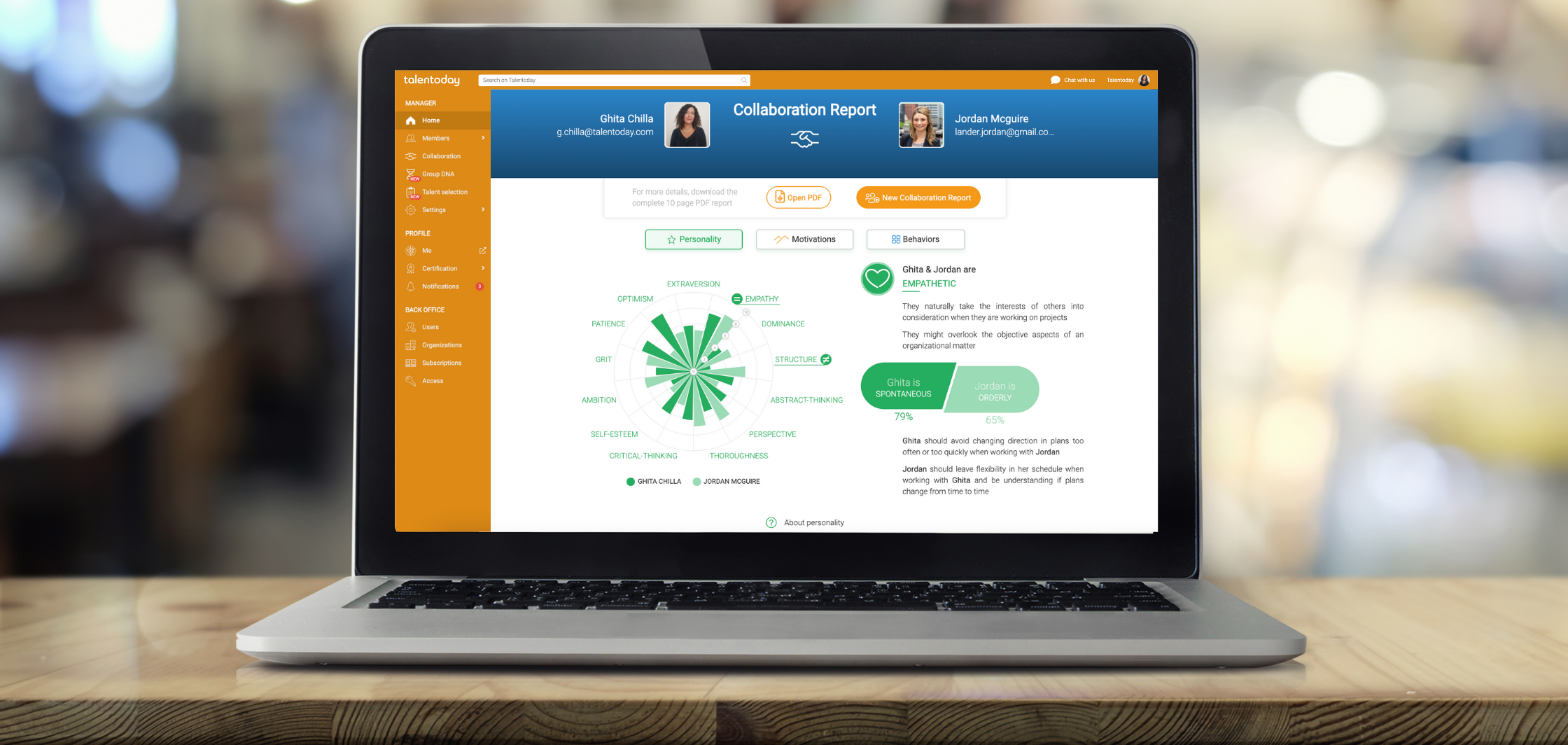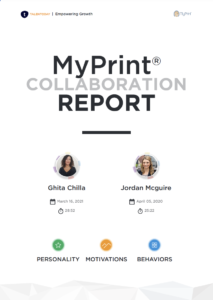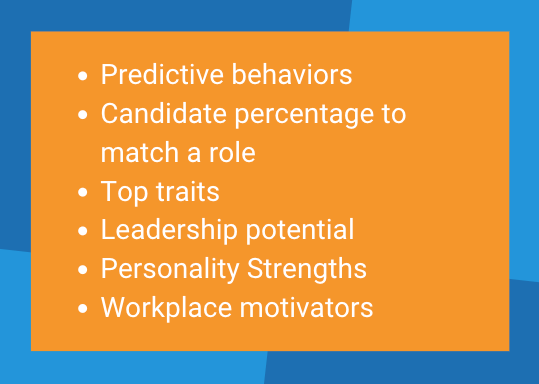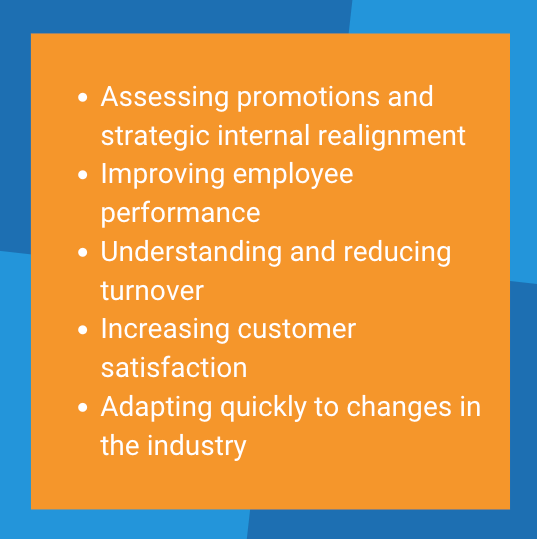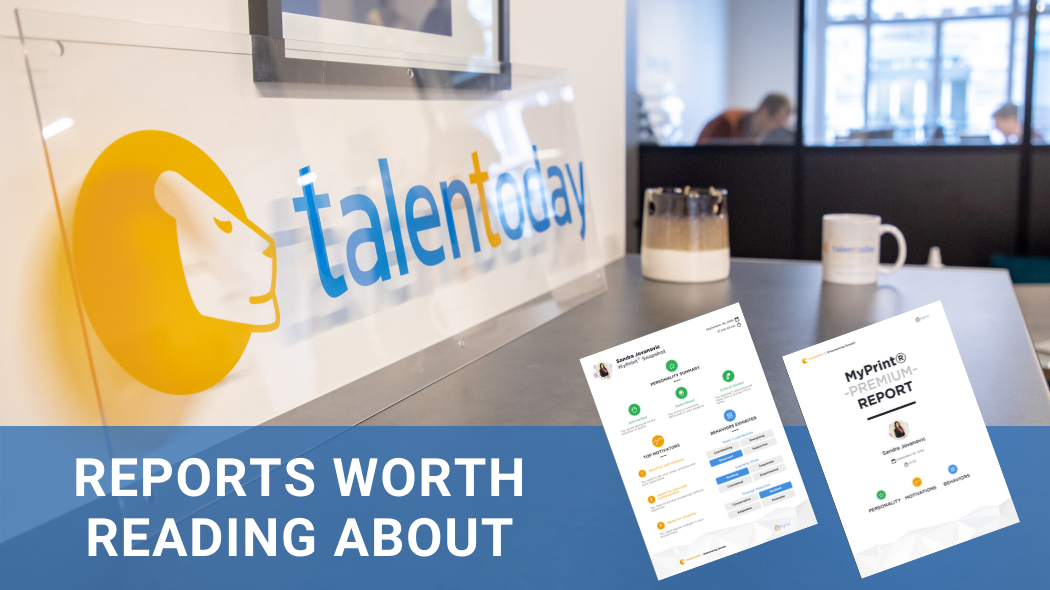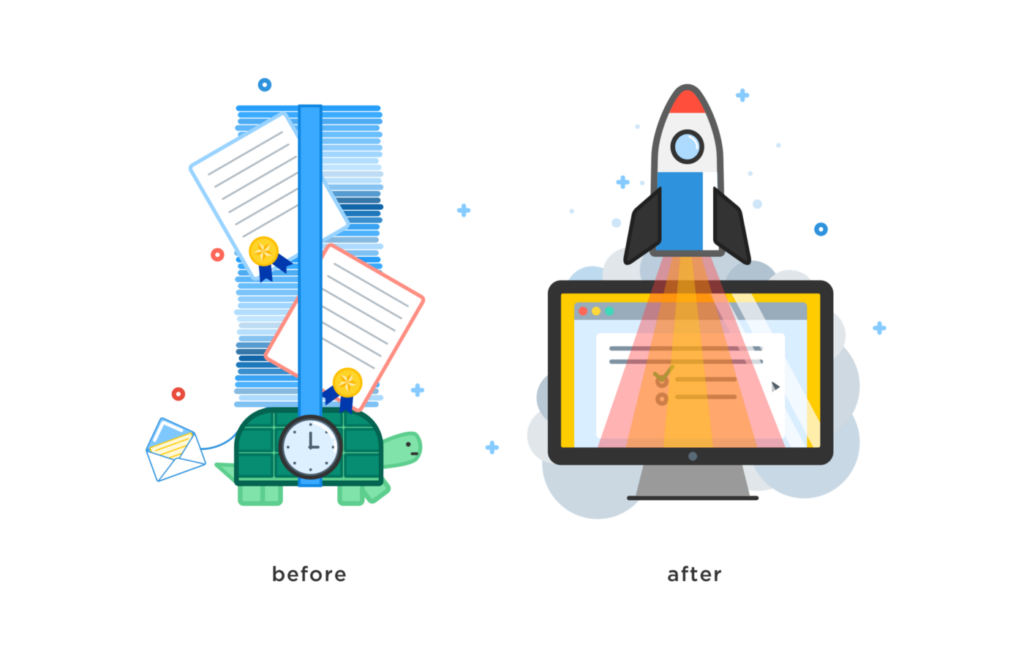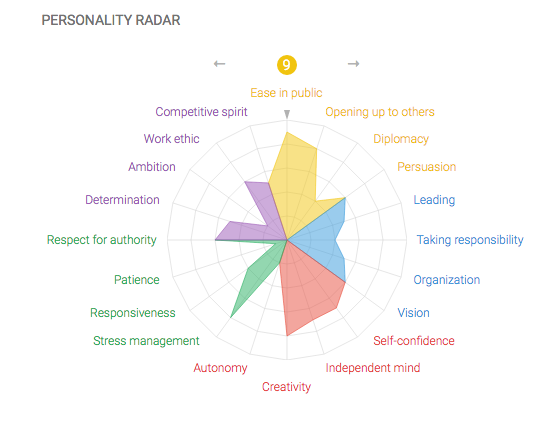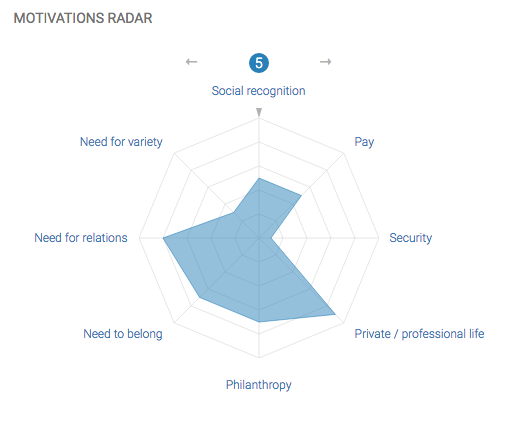Medix Case Study: 68.9% Decrease in New Hire Turnover
Medix implemented the use of MyPrint into our onboarding programs and we’ve seen a positive impact on how we get to know our newest teammates. From personality styles to motivators, the MyPrint Collaboration Report has helped our new hires cultivate strong team relationships, leading to higher levels of engagement, retention and success in their new roles.
– Megan Steiger, VP of Human Resources.
.
THE CHALLENGE: NEW HIRE TURNOVER
With a higher than desired turnover rate for new employees in the first 90 days, Medix turned to Talentoday to determine how to better use soft skills data to reduce turnover rates.
THE SOLUTION: INNOVATION WITH COLLABORATION
With HR working as a strategic business partner, Medix was able to empower managers and their direct reports to have enhanced collaboration with soft-skills data. Medix’s HR team implemented proactive collaboration sessions between managers and new hires based on Talentoday’s Collaboration Report, a 1:1 report designed to compare two individuals’ similarities and differences. The report provides guidance on how they can work better together better based on their unique MyPrint results. By implementing these sessions as proactive and voluntary, the buy-in is high among internal employees.
With HR acting as the facilitator, the manager and new hire are able to use the report to talk through examples that can help motivate them, and what discourages them, empowering engagement to work together towards business goals.
THE RESULT: A 68.9% DECREASE IN NEW HIRE TURNOVER
As a result, Medix saw a significant increase in employees staying with the organization past the first 90 days of employment. In fact, the organization experienced a 68.9 percent decrease in new hire turnover!
.
ABOUT THE CLIENT
Medix, a US-based staffing organization, has been pioneering staffing and digital services over the past twenty years. Being a purpose-led organization, Medix is guided by their core purpose to positively impact lives. In putting people at the heart of what they do, they take an innovative position as both an employer and staffing provider of choice by leveraging soft-skills insights as part of their holistic employee, talent, and client experience.
Since 2018, Medix has been leveraging Talentoday’s soft-skills assessment, MyPrint, and its personality, motivation and behavioral insights as part of their service offering to both talent and clients. Additionally, Medix designated an internal HR representative to champion MyPrint initiatives and infuse people analytics even further into Medix’s employee culture.
Ready to start your transformative Talentoday success story?
Using Technology to Further Your Diversity, Equity and Inclusion Efforts
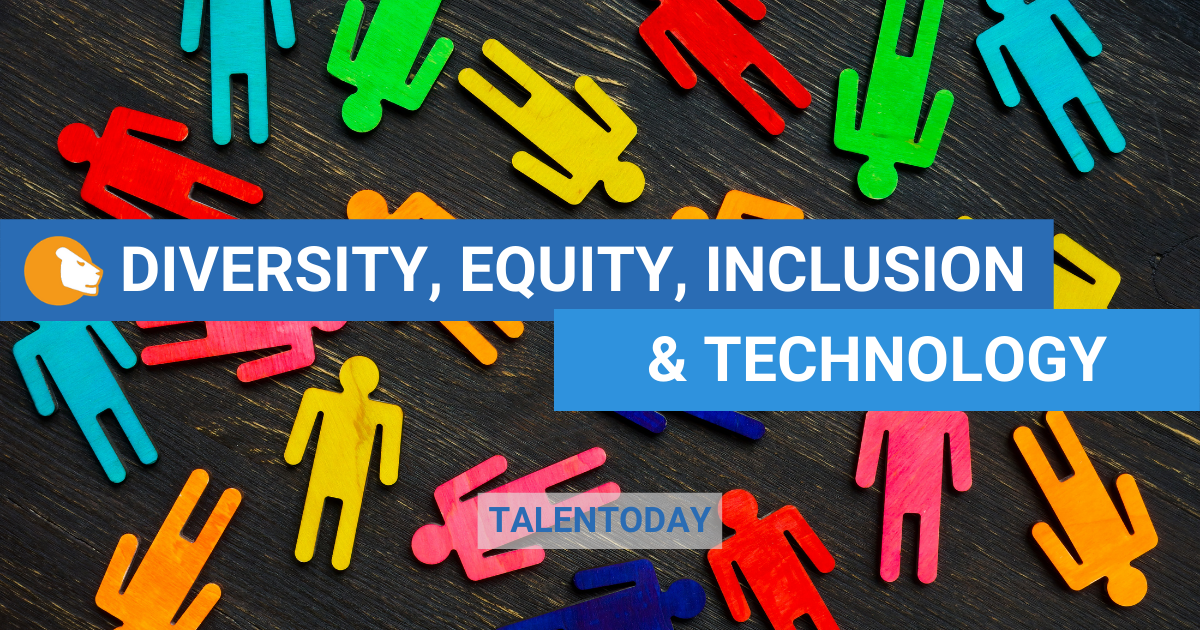
Workplace managers and teams are prioritizing Diversity, Equity and Inclusion (DEI) more now than ever before, and for good reason. DEI helps improve the presence of people of different races, genders, religions, sexual orientations, etc. (diversity); the fair and respectful treatment of all people (equity); and the extent to which all individuals feel respected, accepted and valued (inclusion). DEI also delivers a multitude of benefits that come from having a diverse population in your organization, including: profitability and value creation, innovation, and better decision making.
While business leaders have committed to diversifying their workforce, HR professionals and recruiters are still tasked with hiring the right people. Thankfully, science and technology can help organizations make the right hiring decisions while supporting DEI goals. Digital solutions and tools can help with everything from removing implicit bias from the selection process to predicting how someone will contribute to a team, and understanding how they will behave in a professional setting.
Opportunities and pitfalls associated with diverse hiring efforts
Research shows that bias is present in the hiring process and can start before a candidate walks in the door. For example, certain verbiage can attract more men than women, and people with white sounding names receive more callbacks on average than those with stereotypically black-sounding names. Implementing tools, such as a behavioral assessment, in your selection process can help you to proactively remove implicit biases. You can see a person for their strengths and not lean towards someone who is similar to you.
A common term that is used in the selection process is “culture fit.” However, when maintaining organizational culture becomes the sole focus of this process, it can have the unintentional consequence of hiring different versions of the same person. Allow your core purpose and values to guide you, while being cautious of how you equate those to your “culture” and how you assess a candidate’s ability to uphold your purpose and values. By making room for diversity to be a part of your culture, you will be empowered to celebrate and appreciate the value that each person is adding to your organization.
Diversity beyond what the eye can see
Before blindly jumping into diverse recruiting initiatives, decide what diversity means for your organization. Is it women in leadership? Recruiting and hiring people of color? Creating a comfortable environment that supports various stages of life? All of the above?
Think of the product or service that you’re selling. Can you confidently say that your team is reflective of the people you serve? Having people who can relate to your customer base is vital to the success of your organization. In fact, a team member who shares a client’s ethnicity is 152% more likely to understand the client. In this case, the diversity that we are striving for is easy to identify, and sometimes it goes beyond what we are able to outwardly see.
Understanding the importance of diversity of thought is an important step for your team to reach their highest potential. When team members are able to bring in different perspectives, it helps to create a culture of challenging the norms to allow for new and creative ideas and solutions. These various perspectives are the result of distinct life experiences or work backgrounds and can guide your team to greater successes.
How to leverage science and technology within your DEI efforts
As with any strategic change, diversity within an organization doesn’t happen overnight. It will take months of ongoing planning and years of commitment to become a part of the fabric of your organization. Luckily, there are things you can do immediately to promote equity and inclusion .
Create a culture of openness. Allow for ideas to be heard and create a safe environment for people to propose ideas. Give power to all members of your team to make decisions, and provide actionable feedback to their ideas rather than criticism.
Assess your team to see what areas you are lacking in. Confront skill gaps and then solicit teammates with diverse opinions to help you make business decisions and aid in brainstorming solutions.
Leveraging science and technology is a great way to ensure you are taking implicit biases out of the equation and being efficient in your efforts. Tools such as the MyPrint Collaboration Report are helpful for understanding how differences between two people can be beneficial, and visualizing group data through the Group DNA feature can help to find where your gaps are in your team.
Although change doesn’t happen overnight, there is nothing stopping you from starting the momentum today. Start by fostering inclusion on your team today by telling someone how their work matters. Then, take our complementary MyPrint assessment to start understanding how science and technology can support your goals!
Looking for additional resources and support? Email Talentoday at customer@talentoday.com to learn more about our assessment and services!
Harnessing the Full Power of People Analytics
We all know that recruiting has inherent risk. A CareerBuilder survey found that nearly three in four employers have hired the wrong person for a position. Bad hires not only have a negative financial impact, but can reduce productivity and be a blow to company morale. Even if your initial hire is spot-on, keeping talented employees on board can be extremely challenging. That’s where people analytics comes in. It’s likely you’ve heard or read this phrase before — but what does it really mean?
People Analytics — The Short Version
HR Technologist defines people analytics as “the deeply data-driven and goal-focused method of studying all people processes, functions, challenges and opportunities at work to elevate these systems and achieve sustainable business success.” Simply put, people analytics is:
- Data driven — you need to gather data and use it
- Goal-focused — you need to know how the data will be used and what you want to improve
For human resource and staffing professionals, people analytics has the ability to transform the entire talent lifecycle, from recruitment, assessment and hiring to team building and development. McKinsey data shows that people analytics can lead to an 80% increase in recruiting efficiency and a 50% decrease in attrition. It can also help reduce bias in hiring by bringing in a diverse slate of candidates and create more inclusive workplaces by identifying discrimination.
It’s Only as Good as the Data
As with all science-driven solutions, people analytics is only as good as the data it’s being fed. While certain hard skills and experiences are easy to quantify, understanding soft skills and behavioral factors that determine lasting success requires sophisticated technology.
To get good data, you first need to identify your priorities and objectives. Are you trying to reduce the cost of candidate screenings? Improve the quality of your hires? Create a more diverse workforce? Upfront planning allows you to develop a rigorous candidate assessment, including customized interview questions, that gets to the root of each individual’s personality traits and behavioral and motivational factors. Some data points you may want to consider include:
Once the data is gathered and analyzed, it needs to be compiled in such a way that is accessible to the people that use it. For most of us, visual data representation provides a clear and concise picture that captures our attention and allows us to process the information more quickly.
How Can it Help Your Organization?
People analytics is critical for making better, more informed hiring decisions. While intuition is a valuable tool during recruiting, it shouldn’t be used in a vacuum. Instead, combining your gut instinct with science that uses algorithms and predictive analytics to develop a more accurate and complete talent profile will yield greater success.
Beyond hiring, people analytics is valuable for any area where people are involved in your business, including how you can leverage employee strengths for both the organization’s advantage and the individual’s career growth. Here are a few common examples of areas that businesses can benefit from gathering and using data throughout the employee life cycle:
It’s also important to note that people analytics should never be static. It needs to be a dynamic activity that evolves with individuals and teams as they move through the employment life cycle. The more employees and talent leaders use it, the more value and insights it delivers.
Where do I start?
If you’re looking to make a better placement, team building, and development decisions for employees and teams, assessing soft skills using people analytics software is a great place to start. To learn more about our scientifically-backed assessments, including MyPrint® and Talentoday Manager, email us at customer@talentoday.com. We believe that once you have more information about the personality and motivations of your employees, you’ll be able to make more informed decisions grounded in science.
Unique Results You Can Actually Use
It is human nature to be curious. That is why we hear children ask “why?” over and over again or take the online social media quizzes knowing that there is no validity in their results, but we are simply curious as to what TV character they might say we are or what movie our personality is most like.
When it comes to our personalities and soft skills, the right tools will allow you to leverage technology in order to capture, represent and report our human elements that make us unique in a simple way. That is exactly what Talentoday’s One Page and Premium Reports do!
Whether you are interested in learning more about yourself or thinking about using these reports to manage your team, let’s spend a couple minutes together learning about these two reports.
A Quick Review
After completing the MyPrintⓇ questionnaire, your results will be visualized into reports as a one-page or premium report. There are a total of 26 possible personality traits, 22 motivations and 44 possible behavioral types that will make up your unique results. Just think about the possibilities!
Three high-level definitions to keep in mind before we dive into the reports:
- Personality traits are used to describe the attitude and emotional characteristics of an individual
- Motivators are the reasons an individual acts or behaves in a particular way
- Behaviors help us understand how an individual acts or conducts themselves towards others
One Page Report
If your time is valuable and you want to understand the most pertinent information in a summarized format, then the one page report will be your best friend. This report is separated into three segments, including a personality summary, top motivators and behaviors exhibited. Essentially, it highlights the need-to-know information about your soft skills in each of the three areas and identifies the traits that make you, you!
The personality summary section displays the top three most distinct personality traits an individual possesses based on what Talentoday measures in our questionnaire. The top motivators section displays the top three most distinct motivators for an individual. Lastly, the behaviors exhibited section displays the three predominant behavioral styles of an individual.
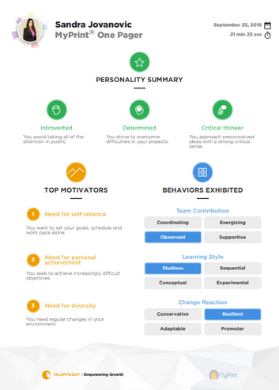
Premium Report
Now don’t worry, because we know comprehensive detail can’t be summarized in one page. So for all you that love to dig into the details, our premium report is perfect for you. This report contains over 30 pages of detailed information about every single personality and motivation trait, as well as your behavioral styles. In addition to the granular details, we see well summarized personality and motivation trait visuals with our easy-to-read personality radar and motivations scale.
The premium report not only provides you with the results and descriptions of your results, but also gives you recommendations on how to use those results. As we dig in to each personality trait, you will find additional tips to review. For motivators, we will not only understand what motivates the individual, but also what can discourage that person. In each behavioral style, we can understand the description of the style, assets, and questions to ask ourselves or the individual whose report we may be reviewing to dig into the behavior further.
Interested in what your personality, motivations and behaviors are but haven’t had a chance to experience MyPrintⓇ Of course, we would be too! Contact one of our Talentoday experts at contact@talentoday.com to experience the questionnaire and view your one page report as soon as you answer the last question. We can’t wait to hear what you think.
Stay tuned for more exciting product news! We know that 2020 is going to be ROARing!
If you’re interested in learning more information about Talentoday, please visit www.talentoday.com or contact our experts at contact@talentoday.com.
Knowledge Transmission and Engaging Expert Collaborators

In a global economy facing constant competition and ever-increasing challenges, companies must ensure the transmission of knowledge and know-how internally in order to move forward and progress. Knowledge management and internal knowledge sharing are crucial for companies to maintain critical skills.
Obstacles linked to human collaboration
Nowadays, the difficulty lies in the ability of organizations to stimulate a dynamic exchange of knowledge, while leveraging employee engagement. Due to a lack of self-confidence, demotivation or simply a lack of recognition from existing employee skills, employees are not always willing to cooperate and share their expertise. Management and managers will need to put in place incentives and develop a culture of recognition to improve knowledge transfer. It is necessary to set up a management system based on trust, a strategic lever in service of performance, for which the organizations HR or L&D leaders would be accountable for managing (1).
Multiple benefits for your company and your employees
The benefits for companies are plural. Knowledge management and transmission have a direct impact on financial gains and cost reduction through: expertise control, speed of task execution, productivity increase, error alleviation, risk management control, and time management for innovation. In fact, employees have increased motivation when they feel that they are acquiring skills quickly and can improve their work. Making them more inclined to change and ready to take up many challenges. In a world seen through the prism of the VUCA model, an acronym for “Volatility, Uncertainty, Complexity, Ambiguity”, organizations need a rapid transfer of knowledge in order to evolve and reinvent themselves, which requires a lot of agility and efficiency.
A new organizational model
New business models must be found while building on the knowledge and know-how, of the company’s core business. A new organizational model has emerged: the learning enterprise (2). In his research Jean-Louis Boutte explains and I quote: “ The company is now considered a living organism, beyond the biological and cybernetic brain, susceptible to organizational learning (Argyris and Schön, 1996). In this model, knowledge is considered as the first wealth and sources of added value. Cross-functionality, systematic networking and a permanent circulation of knowledge foster the emergence of new knowledge and collective intelligence.”
In the digital age, everyone becomes a contributor, designer, producer of ideas, content and opinions. This naturally leads to more collective and cooperative modes of organization that gradually replace pyramidal, hierarchical organizations. Ensuring the management of employees’ knowledge and skills assets becomes a source of sustainable corporate performance and employee employability, loyalty and engagement.
Sources:
- Management par la confiance et performances: Contributions actuelles et perspectives pour la fonction RH, Anne-Sophie Attia, Carole Legros Bradol, Flore de Soultrait et Marco dalla Palma ,Jean-Nicolas Moreau, Université Paris-Dauphine., 2017
- Transmission de savoir-faire, Réciprocité de la relation éducative Expert-Novice, Jean-Louis Boutte, Université de Provence, 2007.
Talentoday Manager launches digital self-service offer to automate process for customers
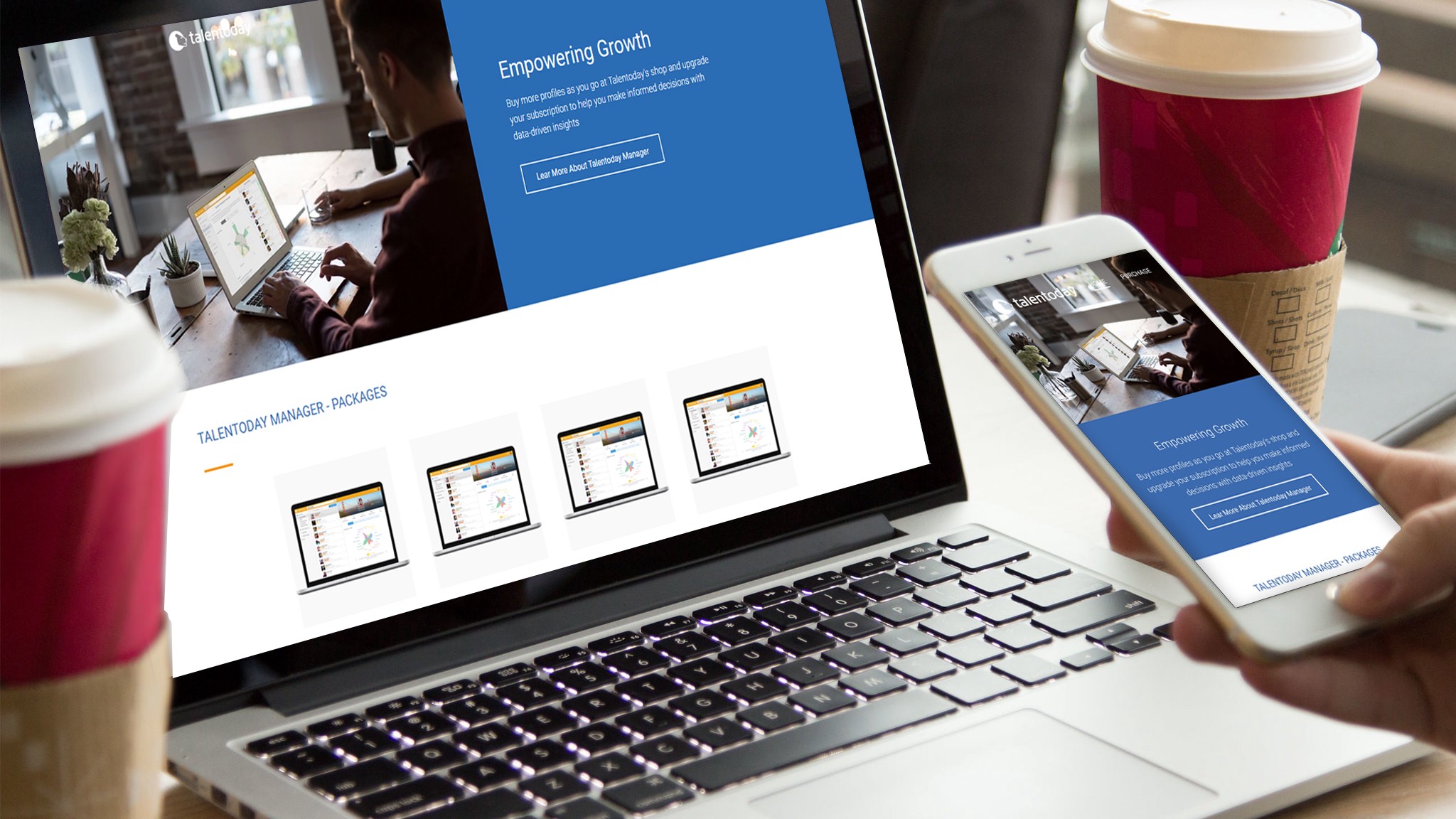
Talentoday, a human centric, people analytics solution that empowers individuals and teams to identify and harness their unique soft skills to grow, recently launched its online shop. I interviewed Benoit Patra, Talentoday’s CTO, and Othmane Lahlou Amine, Key Account Manager, to explain what this initiative means for the company and its customers.
Can you explain what the Talent shop consists of?
Benoît: Our Talentoday Manager solution for HR Professionals is used to better identify talent using an assessment to evaluate an individual’s personality, motivations, and behaviors. Until now, we offered companies unlimited packages that allowed them to recruit one pool of candidates per year to be purchased through their account manager. Then, we realized that one standard offering can be somewhat problematic for some of our clients. Today, we are launching the self-service Talentoday shop, which allows them to buy as many profiles as they need when they need them.
Why did you decide to launch this new and innovative offer?
Othmane: This shop is actually not a surprise for our clients. They requested it, and we made it happen. Our customer satisfaction and feedback drive our innovation, and the shop is actual proof of that. The Talentoday shop now allows them to be autonomous and buy the number of credits they need without any support from the sales or customer success teams. With that said, if anything, this shows that companies are more mature and willing to invest to digitize their HR processes. However, they do not always know where to start, as the scope is quite large. At Talentoday, we offer them a solution that modernizes their recruitment and talent management processes, that is easy to use and access, and that is adaptable to their specific needs.
What is the added value for HR Professionals?
Benoît: The process of purchasing new credits to access additional profiles is completely automated. This allows any HR professional to be fully autonomous, from the order form to invoicing, including refund services and discount offers. Customers buy new packages and pay by credit card or Paypal. We ensure a completely secure payment by partnering with Shopify, a great and proven e-commerce platform.
It is accessible from within the app and for new Talentoday members regardless of the size, location and budget of the company. The only requirement is to have a Talentoday account, which is free and doable in less than 2 minutes.
Othmane: Our client base is extremely diverse, from very small to global; what they shared was the need for autonomy in managing their subscription. The shop allows them to do just that. And by doing so, they save time and money while modernizing their processes throughout their talent life cycle.
In conclusion?
Othmane: The Talentoday shop for HR professionals shows that they can provide their company with a high value-added service, that is easy to use, innovative and accessible by modernizing their image among candidates and employees. Today, HR professionals want and need to be actors in the transformation of their processes. They are convinced that they have a crucial role to play in strengthening their services, and thus enhancing the employer brand; we help them do just that.
People don’t leave companies they leave managers.

7 Keys to Long Term Employee Happiness
When employees quit, it’s not their company they’ve had enough of, it’s their managers.
Forbes reports from multiple data sources like Gallup and Dale Carnegie that 60–70% of employees are not working to their full potential or engaged with the work they’re doing. That’s a frightening majority! And worse, the cost in lost productivity to U.S. companies is more than $450 billion.
There are reasons beyond the boss relationship that might cause an employee to become disengaged and quit. From personal reasons (Harvard Business Review reports a 16% job hunting spike surrounding when people attend school reunions!) to changes in an organization, like layoffs, which can create insecurity. But the key relationship that will make or break an employee’s success at a company is the one he has with his boss. As Harvard Business Review points out, “in general, people leave their jobs because they don’t like their boss”.
The disengagement numbers are shocking, but it’s also an incredible opportunity to increase productivity through making some positive changes.
- Analyze the flight risk of employees, before they leave. Some companies use an outside firm like Joberate to track who employees are connecting with on social media to predict who might be thinking of leaving.
- Create an open dialogue around motivation and job satisfaction. Conduct “stay” interviews to touch base with employees regularly.
- Get data that delves deeply into a person’s motivations with a tool like the Talentoday Manager.
- Offer internal position openings to employees thinking of leaving. Harvard Business Review highlighted Credit Suisse as using this tactic to reduce attrition of 300 employees and saving the company at least $75 million.
- Give employees more freedom. A study of job satisfaction done by Tiny News showed that “those unfortunate souls whose hands are regularly tied are 28% more likely to think about finding a new employer.”
- Don’t work employees to death. Also according to Tiny News’ research, “employees that are tired and burnt out are 31% more likely to think about looking for a new job”.
- Most importantly: hire the right managers. As Gallup CEO Jim Clifton said, “The single biggest decision you make in your job — bigger than all the rest — is who you name manager. When you name the wrong person manager, nothing fixes that bad decision. Not compensation, not benefits — nothing.”
Every employee is motivated differently, and companies need to know what inspires its team. It’s not correct to assume that a raise or a promotion will always work. In fact, research done by CEB shows that “50% of employees who accept a counteroffer leave within 12 months.” When you know what motivates your employees, using a tool like Talentoday’s, you’ll know best how to keep your talent happily in their seats.
Curious to find out if your employees are happy? Start your free trial today to see if you are motivating your team the right way. And if you like this post, please hit the ❤️ button below or give me a shout on Twitter.
How to Build Team Effectiveness: Using Data Driven Recruiting
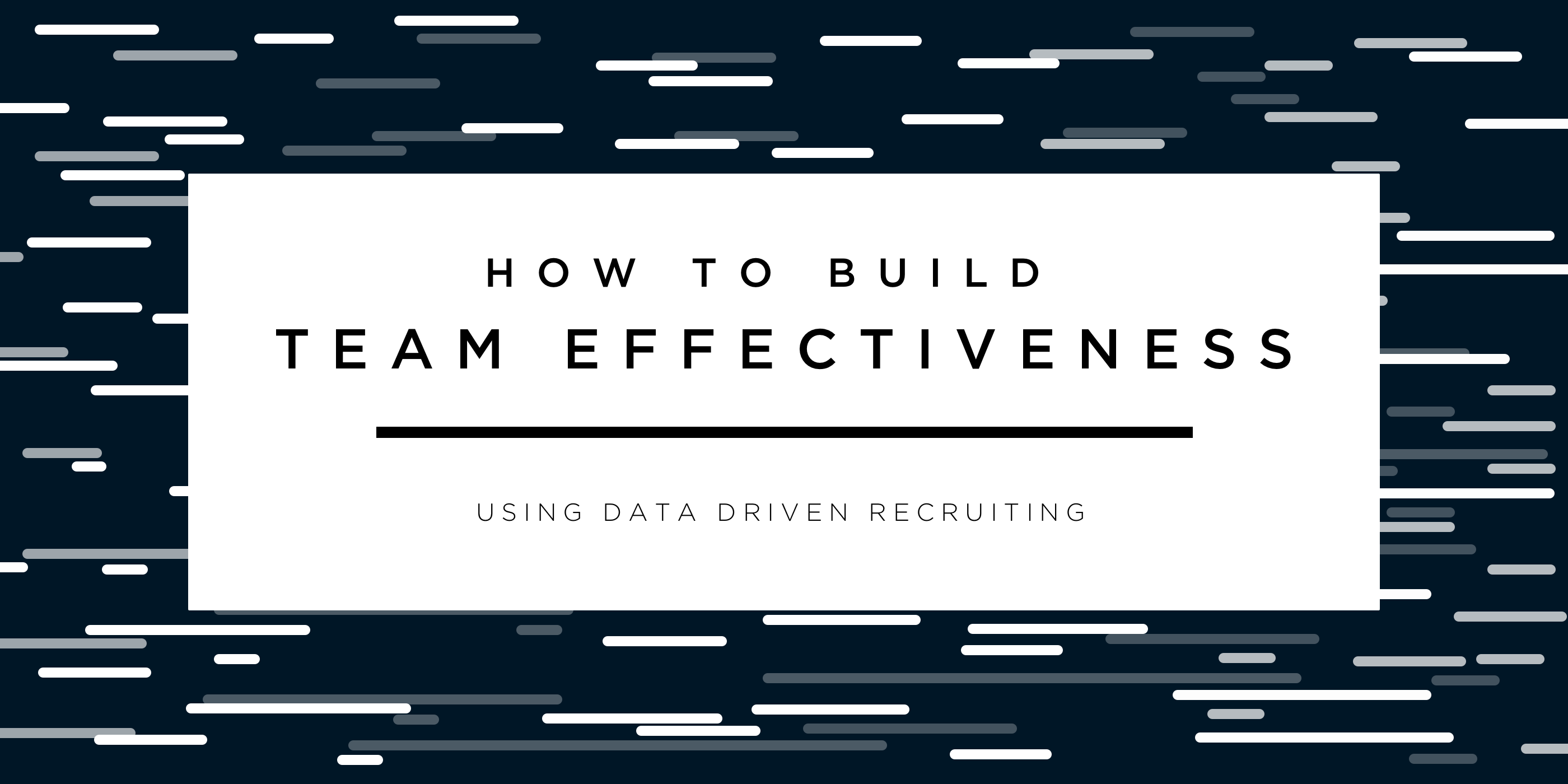
In this three-part series on Team Effectiveness, we first touched on the importance of individual awareness, and the significance of knowing how your soft skills can best serve your team. We then dove into management techniques for creating organic team synergy. Today, the focus is shifted to recruiting.
Traditionally recruiting is done on a need basis. A job needs to be filled, resumes are collected, interviews take place, and things boil down to a gut feeling on who we think we will be the best fit. As we know, time is money, and the quicker the job is filled the happier the company is with you, at least for the time being. We fill the position and hope that our intuition served us right. With all the factors to consider (needs and expectations of the employer’s, needs and expectations of the potential employees) you are juggling a lot of pieces. It is no surprise with the demands placed on recruiting that there is room for disconnect.
The times are shifting from the more archaic way of recruiting (think stacks of resumes, endless email threads, scheduling multiple interviews) to a data driven model that focuses on soft skills rather than previous education, jobs and socio-economic backgrounds. Trying to fit someone to a job with that information alone is like putting together a puzzle without knowing what the end picture will look like. Studies show that it is not one’s past, but their current emotional intelligence that actually sets them up for future career success.
While it’s not realistic for all recruiters to be psychologists, nor is it realistic economically for each individual to go through a psychiatric evaluation with a psychologist, there are HR analytics platforms available that are focused on identifying an individual’s soft skills and not only that, but how they can translate to the workplace.
How can your business benefit from data-driven recruiting? Here are a few ways:
- Focus on soft skills and how they fit in the workplace. Team interactions boil down to individual personalities and motivations and that’s not what you find on a resume.
- It saves you time. These tests are done online and by the individual on their own time. All you have to do is read the results. This could save you time scheduling, facilitating and possibly a few interviews.
- It is measurable. With all this data at your fingertips, there is endless ways to manipulate it in order to measure growth, strategize for the future, or see trends. It seems like it would only get better over time too…imagine if you had the soft skills not only for the person who you are trying to recruit but the one who you are replacing. Your job would be finding the perfect match, and the data could help you.
What does this really look like? Talentoday has a personality test and job matching platform out there designed by top data scientists and psychologists. The assessment tests over 20 personality traits and 8 professional motivators and allows you to compare candidates against each other. Results can look something like this:
If employee retention and creating a strategy for hiring in the future is something you would like to get involved with, it may be time to move into the modern era of recruiting and give data a chance.
Eager to please your clients with data and recommend the candidates that fit the job? Check out our page to sign up for for your free trial of Talentoday Manager. And if you like this post, please hit the ❤️ button below or give me a shout on Twitter.
How to hire a super star sales professional.
3 unique traits in those who close deals
A great product or service can easily go unnoticed if it does not have the right people to sell it. As a hiring manager, how can you find sales stars that shine? With thousands of sales professionals in our data base, we have created a profile on what makes an individual a great deal closer — & it is not what you may think. According to our data, top sales performers display the following traits:
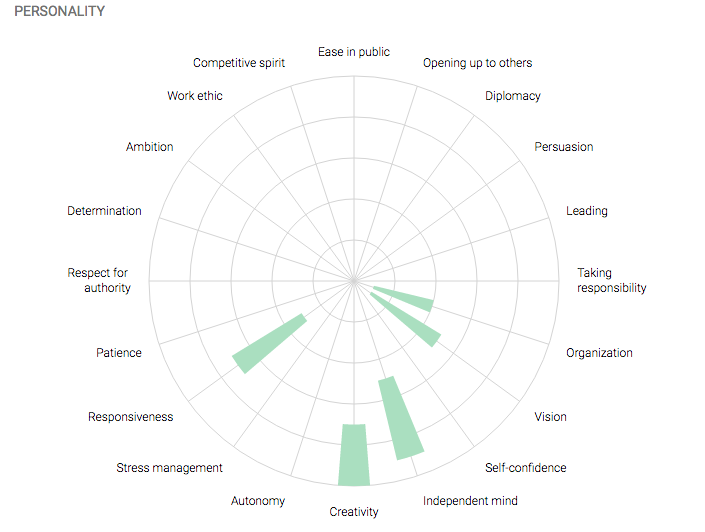
#1 Creative: Lives (and thinks) outside the box
There are many ways to sell a product or service, and the same approach is not right for everyone. Creativity is often required to take a customer from “maybe” to “yes” and close a deal.
A successful salesperson thrives in an environment where they need to constantly adapt to changing goals and creatively solve problems on a daily basis. You don’t want someone who sometimes thinks outside the box, you want someone who doesn’t know that the box even exists.
#2 Responsive: Intuition based decision making
Have you ever felt like the car salesman down the street read your mind? Well, they did. Salesmen/women rely so heavily on their intuition that they can easily get in their customers head and are usually two steps ahead. Genuine sales professionals are quick on their feet, and favor spontaneous action over reflection.
But while they are quick they are also swift and can adapt to a new situation at the drop of a hat. Their chameleon like nature allows them to respond to the personalities of a rainbow of potential customers.
Team members who have mastered the art of clear and consistent communication with their clients will lead your company to higher customer satisfaction, and a better bottom line as a result.
#3 Independent mind: Supervision not required
A rockstar salesperson should be able to take a goal and run with it. That means setting their own schedule and ensuring that all relevant goals are met on time.
Self motivation is crucial, especially in environments where sales reps work remotely or travel frequently. Managers should be able to support their teams without getting in the weeds on day-to-day details.
The total superstar sales package
The key to making a sale is understanding customers’ needs and figuring out how your product or service can meet them — the intersection of creativity, responsiveness, and independence. Find someone who has all three and you are well on your way to success.
While every employee is unique, these insights may help you determine which applications rise to the top of the pile. For help hiring your next sales professional use this job matching system to see how your candidates stack up against your current sales team. Stop relying on your gut instinct for hiring (leave that to sales) and start making data-driven decisions.
Want to read more recruiting tips and tricks? Check out my blog page.
HR Hack: The Secret to Tying Down Millennials.
Where will all the grads go?
And more importantly, will they stay put? Nearly two million members of the Class of 2016 in the U.S. have hit the job market this summer, and the outlook is strong.
A survey from the National Association of Colleges and Employers finds that employers are planning to hire about 5 percent more new college graduates than last year, and the Bureau of Labor Statistics reports that the unemployment rate for those over 25 with a bachelor’s degree is 2.4 percent, less than half of the national average of 5 percent.
While the job outlook is strong, Millennials are looking for more than just a job — they want a career that they are passionate about. And they will not settle for anything less.
Millennials have different needs than previous generations.
According to a study from Bentley University, “Millennials have not rejected the corporate world, but they will seek other options, such as starting their own companies, if they cannot find workplaces that accommodate their personal values — prominent among them time allocation, relationships and job security.”
How to attract the best Millennials to your company
In order to recruit and retain Millennials, you first need to understand their needs. It is essential that companies invest in their candidates from the very beginning… and that means getting to know them — inside & out. This generation has been described as everything from self absorbed to free spirited.
While making sense of Millennial preferences might seem like a tall order, a simple personality questionnaire puts it within reach. HR managers and recruiters can now use a psychometric assessment to uncover a person’s motivations, leadership style, and more.
This is a vital resource for understanding the mindset and strengths of today’s college graduates. I reached out to a recent grad who was on the hunt for a job she could invest herself in. As a millennial in the tech start up world, Addison wanted to see just how accurate this assessment was at gauging her unique needs.
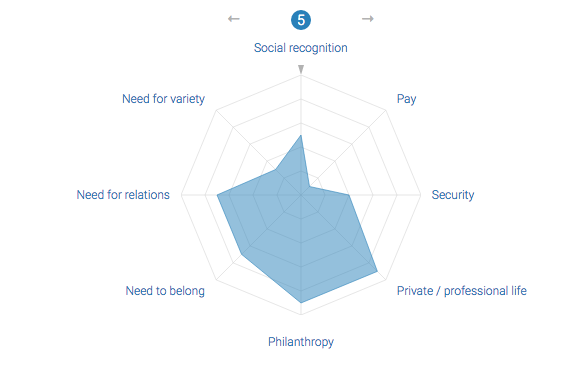
Addison noted, “my motivation radar was spot on. Without relating to others on my team coupled with a strong work life balance, there is no amount of money that can keep me happy at a mediocre job.”
But these are just Addison’s unique results, employers must find ways to meet expectations of the new generation’s vast and diverse motivators.
Investing in employees is more important than ever, especially if your company plans on retaining them. To get a better idea of what a millenial will need to be a glowing and fulfilled asset to the team; it is best to do the extra work during the interview process, or you may see them heading for the door.


